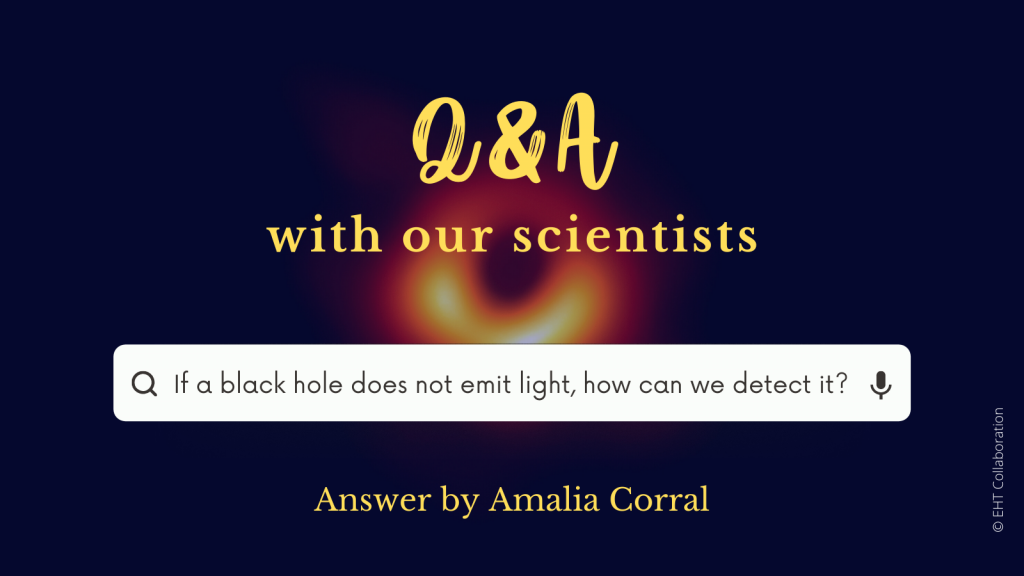
Question: If a black hole does not emit light, how can we detect it?
Answer:
Reality is, BHs are relatively easy to detect since we can see how they affect their surroundings. BHs come in all sizes: from microscopic primordial BHs, to stellar BHs from Supernovae, to Super Massive BHs at the centre of galaxies https://www.esa.int/…/Black_hole_in_a_strong_magnetic…
Option 1: gravity. In binary stellar systems, the mass of the system can be derived by studying the orbit of the star we can see. In the case of SMBHs, we study the movements of the stars and gas closest to it https://upload.wikimedia.org/…/commons/5/50/SgrA2018.gif(credit @ESO @MPE_Garching).
Option 2: catch them while they are eating (accreting matter). When this happens, this matter heats up and becomes extremely bright. SMBHs that are actively engulfing matter are the brightest persistent objects in the Universe https://esahubble.org/wordbank/quasar/(Credit ESA – European Space Agency).
Option 3: just take a picture. We cannot see them directly, but we can see their shadow. In 2019, the Event Horizon telescope (EHT, composed, in fact, of 8 telescopes around the world), produced the first image of a Black Hole https://static.projects.iq.harvard.edu/…/m87_lo_april11… (Credit: Event Horizon Telescope).
Option 4: catch the wave. When two BHs collide, the disruption of space-time they produce propagates through the Universe as Gravitational Waves. We detected them for the first time in 2015 https://upload.wikimedia.org/wikipedia/commons/b/b8/Wavy.gif(Credit: NASA Jet Propulsion Laboratory).
Only one of these types of black holes have not been detected yet: primordial black holes. If they are found, they could help us solve one of the remaining mysteries about our Universe: the nature of Dark Matter https://cdn.mos.cms.futurecdn.net/P3WVJSbJ6ZDtPNuobobSth…(Credit: Caltech IPAC).
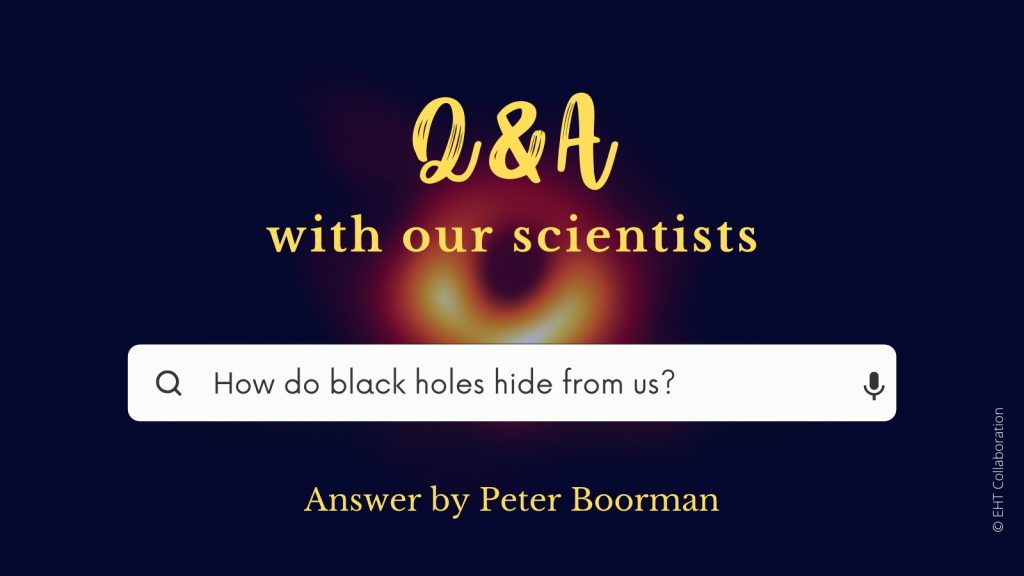
Question: How do black holes hide from us?
Answer:
Black holes are greedy. Even as they’re devouring stars, planets, and other space debris, they can’t help but prepare for their next meal by piling up more interstellar scraps around them. The majority are hiding from us behind these food reserves, aka “the obscurer” https://www.nustar.caltech.edu/image/nustar151217c (Credit: @NASAJPL).
But black holes don’t know when enough is enough. Research suggests that more and more food is accumulated in the obscurer until the black hole can’t keep hold of it. At this point, excess food is surged outwards via an outflowing wind into the surrounding galaxy https://www.eso.org/public/videos/eso1327a/ (Credit: @ESO).
Much like doctors can understand the structure of bones in their patients with X-ray scanners, we use X-ray space telescopes to understand the structure of the obscurer. For example, using data from @nasanustar, @chandraxrayobservatory & #Suzaku we studied the dense obscurer in IC 3639 (see image) https://www.nustar.caltech.edu/image/nustar170107b (Credit: @NASAJPL @ESO).
But there’s still a lot more to learn! With next-generation observations from @AthenaXIFU, we will map out the complex dynamical geometry of this multi-component obscurer in unprecedented detail and study its role as a link between the black hole and surrounding galaxy https://www.desy.de/sites2009/site_www-desy/content/e428/e548/e4802/e274718/e274917/e274980/PM_DESY_Blazar_quer_A4_300DPI_ger.jpg

Question: How massive are black holes?
Answer:
We study black hole masses by comparing to our sun: 1 Solar Mass (M🌞), 2*10^30 Kg or 333,000 times the mass of earth! #BlackHoles can be tiny to billions of M🌞 https://www.nasa.gov/sites/default/files/thumbnails/image/pia18842-harrison-2.jpg (Credit: @NASAJPL)
There are 4 kinds (my fave are supermassive):
Primordial: Very small and formed in the early universe, a few 10^11 kg to 1 M🌞.
Stellar: Formed from collapsing stars and are in the range of 1-100 M🌞.
Intermediate: From 100 M🌞 to 1 million M🌞. Our best detection is one with 160 M🌞 by gravitational waves, and almost none proved between 160 and 1 million M🌞
Supermassive: A million M🌞 and more!
https://upload.wikimedia.org/wikipedia/commons/5/58/A_black_hole_of_puzzling_lightness.jpg (Credit: @esa @Hubble_space)
Supermassive BHs are the biggest and best! They also sometimes have very powerful jets.
Check out this paper to learn about mass estimates of some SMBHs: https://tinyurl.com/2p93h88b
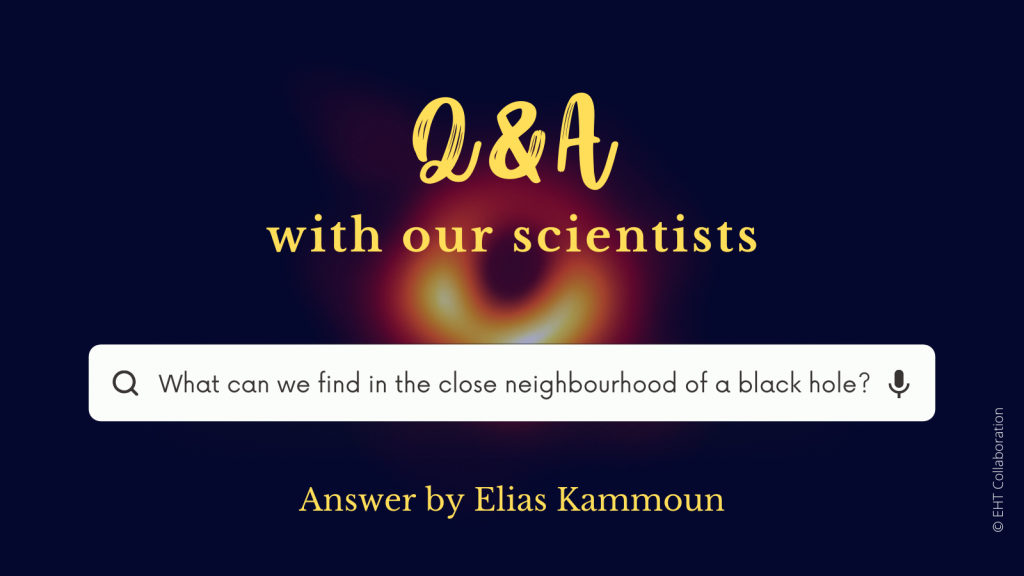
Question: What can we find in the close neighbourhood of a black hole?
Answer:
Most black holes wander alone. This makes it harder to detect them. Luckily, in some cases, we find material falling into a black hole. This material forms a flattened disc heating up, thus radiating electromagnetic waves, as it gets closer to the black hole, making it easier to detect.
In the center of the disc, close to the black hole, there is a region of very hot electrons, with temperatures of around a billion degrees. It is known as the corona and produces high-energy X-rays that are emitted in all directions https://web.archive.org/web/20150321104026/http://www.jpl.nasa.gov/spaceimages/details.php?id=PIA16695 (Credit: @NASAJPL).
The material next to the #BlackHole does not only spiral down into the black hole. In some cases, this material can be ejected in the form of disc winds or collimated jets injecting material & energy in the galaxy hosting the black hole, or even reaching the intergalactic medium https://sci.esa.int/web/xmm-newton/-/50098-artist-s-impression-of-galactic-outflows-and-jets (Credit: @esascience @ESA_XMM).
@AthenaXIFU will help us understand how #BlackHoles could shape the universe by studying their close environment: the emission from the discs, the geometry and the nature of the corona, and the properties of the outflowing material https://www.the-athena-x-ray-observatory.eu/media/rokgallery/5/558a40ac-a78f-4a40-d502-2a78d3afc1cc/X_IFU_Wissh_spectrum_50ks.jpg (Credit: @DidierBarret).

Question: Do black holes grow?
Answer:
Astronomers are convinced that every galaxy in the Universe contains a massive black hole at its center. Over their life, the massive black holes grow, reaching up to billion times the mass of the Sun https://astropix.ipac.caltech.edu/archive/eso/potw2206d/eso_potw2206d_1024.jpg (Credit: @ESO)
Matter in the form of gas, dust and stars, falls toward the event horizon of a black hole. It heats up, emitting an enormous amount of radiation that can be observed from billions of light years https://astropix.ipac.caltech.edu/archive/wise/wise2016-001/wise_wise2016-001_1024.jpg (Credit: @NASAJPL @caltechipac)
In the early Universe, it is likely that a black hole merge with one another, significantly growing most of its mass https://astropix.ipac.caltech.edu/archive/chandra/436/chandra_436_1024.jpg (Credit: @NASA @ChandraCDO @MIT @STScI)
The role of @AthenaXobs will be crucial in our understanding of the black hole growth in the Universe, by unveiling the processes that dominated the early growth and the physics of material accretion ▶️ https://bit.ly/3y7SoDv
https://www.the-athena-x-ray-observatory.eu/media/rokgallery/f/f428df79-33ce-40e5-dc60-eced8456f11f/Athena_AGN_artisticview.jpg (Credit: @esa @NASA @IRAP_France @CNES @CNRS_Toulouse)
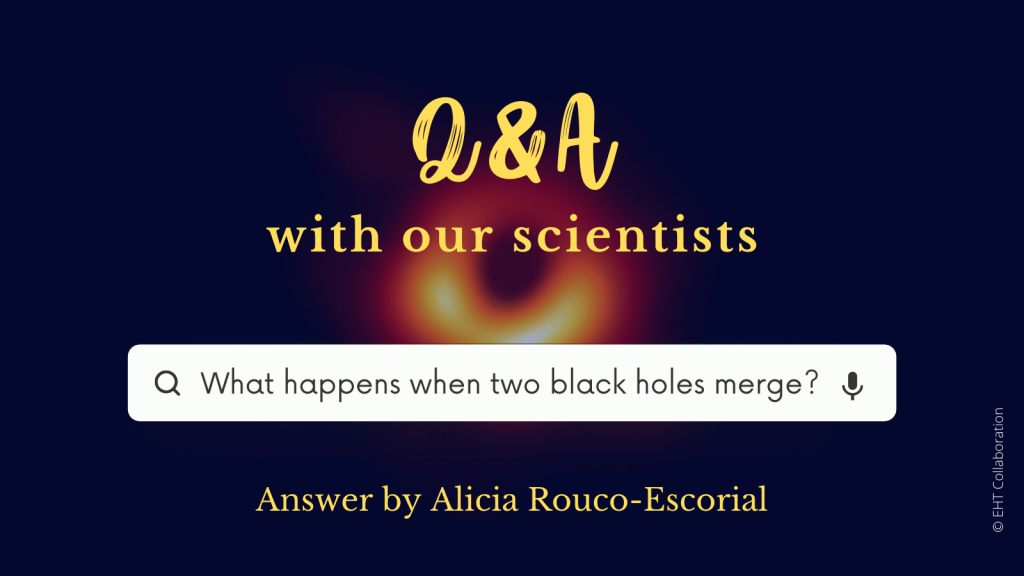
Question: What happens when two black holes merge?
Answer:
Black holes are the most massive and most compact objects in the Universe. Their gravitational pull is such that nothing, not even light, escapes from them. What happens when 2 such monsters collide? https://astropix.ipac.caltech.edu/archive/chandra/436/chandra_436_1024.jpg (Credit: @NASA @ChandraCDO @MIT @STScI)
When two black holes form a pair, they attract each other due to their gravity. The orbit of the pair shrinks with time while the black holes expel gas and matter into space. Video: @LIGO @ego_virgo
As these two black holes get closer and eventually merge a more massive black hole is formed and a huge amount of energy is released generating gravitational waves. Video: Max Planck Institute for Gravitational Physics.al waves
These gravitational waves are ripples in spacetime travelling through the Universe that we detect thanks to the advanced LIGO/VIRGO/KAGRA detectors. Video: @LIGO

Question: What do we know about super massive black holes?
Answer:
The massive #galaxies and a fraction of lower mass galaxies in the Local Universe host a supermassive black hole in their center. They have masses between millions to 10 billions times the mass of our #Sun https://www.eso.org/public/images/eso0903a/ (Credit: @ESO).
They probably come from massive stars 100 solar masses or higher that were formed when the Universe was at its infant state about 300 million years after the big bang. These grew through intense accretion probably associated with heavy obscuration as simulations show https://astronomy.com/magazine/news/2021/03/how-to-grow-a-giant-black-hole (Credit: @ESO).
When matter from the galaxies starts to fall into the supermassive black hole, an enormous amount of energy is released. These galaxies, then, are called active galaxies and these phenomena are also well-known as Active Galactic Nuclei. Active galaxies require that gas and dust are in the act of falling into the black hole and glowing brightly on the way in https://www.eso.org/public/images/eso0903a/ (Credit: @ESO) .
In many cases, the power of a single Active Galactic Nucleus with a size that is similar to our Solar System is much higher than the power emitted by the entire stellar population of its host galaxy and its luminosity may overshadow the light emitted by the galaxy http://www.southampton.ac.uk/~pg3e14/nakshatra/nakshatra.html (Credit: @HubbleTelescope).
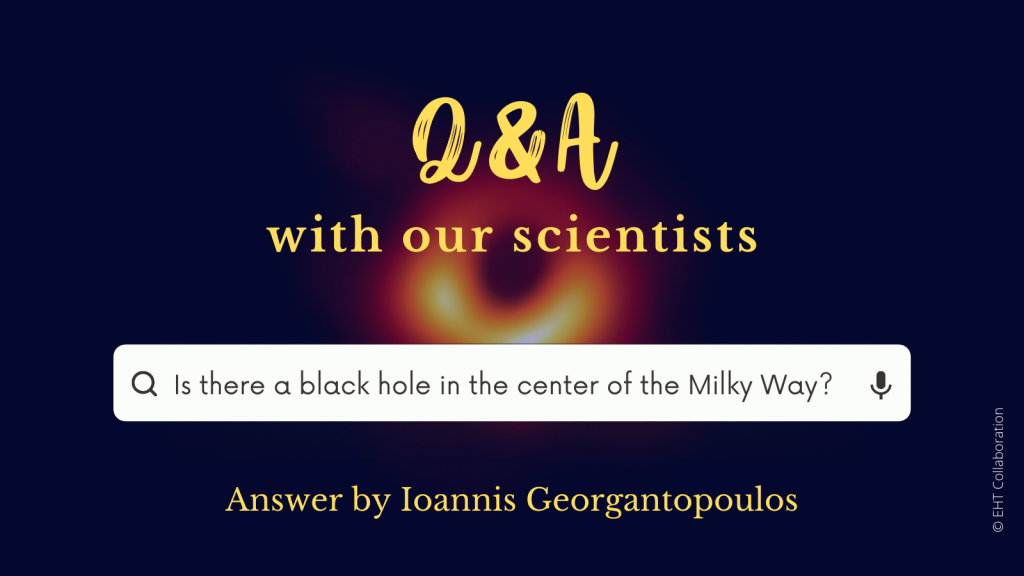
Question: Is there a black hole in the center of the Milky Way?
Answer:
The supermassive black hole at the center of the Milky Way galaxy coincides with the radio source Sagittarius A* (Sgr A*) in the constellation of Sagittarius (the Archer). The black hole has a mass equal to about 4.3 million suns and has a diameter of 23.6 million kilometers (less than half the earth’s distance to mars) https://www.nasa.gov/sites/default/files/sgr_lg.jpg (Credit: @chandraxray).
The black hole mass of Sgr A* was calculated using the stars that are very close to it and have been observed for many years. Their orbits depend on the mass and the distance of the object they’re orbiting. By tracking these stars’ movements the black hole mass can be found https://cdn.eso.org/images/publicationjpg/eso1825d.jpg (Credit: @ESO).
Sgr A* is supermassive, though the Milky Way is not considered an active galaxy. The latter requires that gas and dust are in the act of falling into the black hole and glowing brightly. As there is no material falling into SgrA* the black hole remains inactive https://www.eso.org/public/images/eso0846a/ (Credit: @ESO).
